News reports in China have stated that the Chinese are will attempt to join the nations capable of sending humans into space on October 15, a day after the meeting of Communist party members. The Shenzhou 5 spacecraft will carry a single astronaut (or yuhangyuan) into space for a single 90-minute loop around the Earth. It appears the Chinese are going to be very conservative on their first launch attempt, essentially matching the flight that Yuri Gagarin made more than 40 years ago. There hasn’t been an official launch announcement from the government yet.
Book Review: Hubble: The Mirror on the Universe
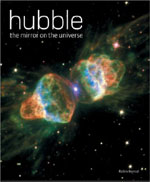
“Hubble: The Mirror on the Universe” by Robin Kerrod is the newest coffee table book filled with beautiful pictures from the Hubble Space Telescope. The 192-page hardcover contains hundreds of pictures, of objects as near as our solar system to the very edges of the Universe.
The book is categorized into different kinds of astronomical objects, so the chapters go like: Stars in the Firmament, Stellar Death and Destruction, etc. Each chapter is broken up into a collection of images from Hubble that relate to the topic, and then a nice description of what’s going on in the picture. Robin Kerrod is an accomplished astronomy writer (The Sky at Night, History of NASA, more) and it really helps to have a knowledgeable guide take you through the pictures. There are also plenty of full page, and even two-page spreads dedicated to some of the best pictures from Hubble.
The book was only published in September 2003, so its big advantage to all the other Hubble coffee table books is that it’s got the newest photos. I noticed some pictures that were only released a few months ago.
What surprised me when I read the book is that it’s really an overview of astronomy, using pictures from Hubble as a background to the descriptions. Instead of ignoring things that Hubble hasn’t taken pictures of, Kerrod included pictures from other sources other than Hubble – I think this was a wise move because it makes the book a more complete view of space and astronomy than a narrow view through the Hubble mirror.
The pictures are beautiful, no argument here – you’ll recognize many of them. And the text is comprehensive and well-written. There’s really good background information on the observatory itself; how it was built, launched, repaired and upgraded.
Although it was great to see additional text and pictures to make the book a more complete view of astronomy, the non-Hubble pictures aren’t clearly marked. Sometimes there’s a mention in the image caption, and there are image credits at the back of the book, but it would have been helpful if they stated it clearly beside the images. So, you can’t assume that every picture you’re looking at was actually taken by Hubble.
Here’s a link to more information from Amazon.com – Amazon.ca – Amazon.co.uk
Pengiuns Get a Boost from Plankton Blooms
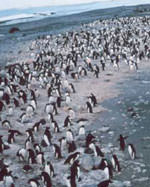
Image credit: NASA
NASA satellite data has been used to analyze the biology of open area “hotspots” around the coast of Antarctica. The research has found that penguin populations are healthy when there are patches of open water nearby where plankton blooms can form in the sunlight. The plankton feeds shrimp-like krill which supports many other marine animals including penguins. The data was gathered by NASA’s Sea-viewing Wide Field-of-view Sensor (SeaWiFS) and NOAA’s Advanced Very High Resolution Radiometer (AVHRR) which kept weekly records of ocean temperature and plankton levels.
NASA satellite data was used for the first time to analyze the biology of hot spots along the coast of Antarctica. The biological oases are open waters, called polynyas, where blooming plankton support the local food chain.
The research found a strong association between the well being of Adelie Penguin populations in the Antarctic and the productivity of plankton in the polynyas. Polynyas are areas of open water or reduced ice cover, where one might expect sea ice. They are usually created by strong winds that blow ice away from the coast leaving open areas, or by gaps appearing on the ocean’s surface, when flowing ice gets blocked by an impediment, like an ice shelf.
The Antarctic waters are rich in nutrients. The lack of ice, combined with shallow coastal waters, provides the top layers of the ocean with added sunlight, so polynyas offer ideal conditions for phytoplankton blooms. Because the ice around polynyas is thin in the early spring when the long Austral day begins, they are the first areas to get strong sunlight. The open waters retain more heat, further thinning ice cover and leading to early, intense, and short-lived plankton blooms. These blooms feed krill, a tiny, shrimp-like animal, which in turn are eaten by Adelie Penguins, seabirds, seals, whales, and other animals.
Although relatively small in area, coastal polynyas play a disproportionately important role in many physical and biological processes in Polar Regions. In eastern Antarctica, more than 90 percent of all Adelie Penguin colonies live next to coastal polynyas. Polynya productivity explains, to a great extent, the increase and decrease in penguin population.
“It’s the first time anyone has ever looked comprehensively at the biology of the polynyas,” said Kevin Arrigo, assistant professor of Geophysics at Stanford University, Stanford, Calif. “No one had any idea how tightly coupled the penguin populations would be to the productivity of these polynyas. Any changes in production within these polynyas are likely to lead to dramatic changes in the populations of penguins and other large organisms,” Arrigo said.
The study, which appeared in a recent issue of the Journal of Geophysical Research, used satellite-based estimates to look at interannual changes in polynya locations and sizes; abundance of microscopic free-floating marine plants called phytoplankton, which are the base of the polar ocean food chain; and the rate at which phytoplankton populations thrive. Covering five annual cycles from 1997 to 2002, 37 coastal polynya systems were studied.
The largest polynya studied was located in the Ross Sea (396,500 square kilometers or 153,100 square miles; almost the size of California). The smallest was located in the West Lazarev Sea (1,040 square kilometers or 401.5 square miles). Most polynyas, at their maximum area in February, were less than 20,000 square kilometers (7,722 square miles).
Data from NASA’s Sea-viewing Wide Field-of-view Sensor (SeaWiFS) and NOAA’s Advanced Very High Resolution Radiometer (AVHRR) provided weekly measurements of chlorophyll and temperature that were used in a computer model to estimate phytoplankton productivity. The researchers found, taken together, the Ross Sea, Ronne Ice Shelf, Prydz Bay, and Amundsen Sea polynyas were responsible for more than 75 percent of total plankton production.
The researchers were surprised to find how closely connected the Adelie Penguins were to the productivity of their local polynyas. The more productive polynyas supported larger penguin populations. The more abundant krill fed more penguins, and the birds had shorter distances to go to forage, which reduced exposure to predators and other dangers.
The NASA Oceanography Program, the National Science Foundation, and the U.S. Department of Energy funded this research. NASA’s Earth Science Enterprise is dedicated to understanding the Earth as an integrated system and applying Earth System Science to improve prediction of climate, weather, and natural hazards using the unique vantage point of space.
Original Source: NASA News Release
Chinese Could Launch Very Soon
The Chinese might be days away from launching their first humans into space, according to various experts and insiders. Normally quiet about future launch plans, the Chinese government is starting to make more comments about what could happen soon – the launch could happen as early as this weekend, but others believe the launch won’t happen before October 15 as government officials are in a series of meetings and would like to be present for the launch. All of the astronauts (or yuhangyuan) are at the launch facility and the Shenzhou 5 spacecraft has been mated to the top of its Long March rocket.
Virgo Cluster Sucks in Distant Galaxy
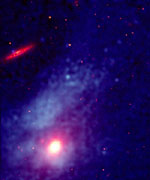
Image credit: Chandra
A new image taken by the Chandra X-Ray Observatory shows the elliptical galaxy M86 and its 200,000 light-year long tail. This gigantic galaxy is located in the Virgo galaxy cluster and moving 4.8 million kilometres per hour through clouds of gas in the cluster. The Virgo cluster is hurtling away from us, but M86 is on the opposite side and being pulled into it, so the net effect is that M86 is actually one of the few galaxies actually moving towards our own Milky Way.
This composite X-ray (blue)/optical (orange) image of M86 shows gas being swept out of the galaxy to form a long tail more than 200,000 light years in length. Located in the Virgo galaxy cluster, this enormous elliptical galaxy is moving at about 3 million miles per hour through diffuse hot gas that pervades the cluster. The supersonic motion of M86 produces pressure that is stripping gas from the galaxy and forming the spectacular tail.
M86 has been pulled into the Virgo galaxy cluster and accelerated to a high speed by the enormous combined gravity of dark matter, hot gas, and hundreds of galaxies that comprise the cluster. The infall of the galaxy into the cluster is an example of the process by which galaxy groups and galaxy clusters form over the course of billions of years.
The galaxy is no longer an “island universe” with an independent existence. It has been captured and its gas is being swept away to mix with the gas of the cluster, leaving an essentially gas-free galaxy orbiting the center of the cluster along with hundreds of other galaxies.
M86 is an unusual galaxy in that it is one of a small number of galaxies that are moving toward Earth, rather than receding with the general expansion of the Universe. This expansion is carrying the Virgo cluster away from us at a speed of about 2 million miles per hour, but M86 is falling into the Virgo cluster from the far side of the cluster, giving it a net velocity of about one million miles per hour toward Earth.
Original Source: Chandra News Release
Small Asteroid Came Very Close
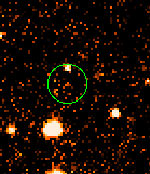
Image credit: Lowell Observatory
Asteroid 2003 SQ222 whizzed by the Earth last week, missing us by only 88,000 kilometres. The rock wasn’t large, only 3 to 6 metres across, but if it had hit the Earth it probably wouldn’t have caused damage as would burn up in the atmosphere. The asteroid was discovered by the Lowell Observatory and several amateur astronomers who collaborated to track its motion as it flew away from the Earth – unfortunately, they didn’t notice it until it had already passed us. Objects of this size do strike the Earth about once a year, and create a spectacular fireball in the sky for anyone lucky enough to spot it.
A small asteroid, perhaps 3 to 6 meters in diameter?the size of a room or house?came within 88,000 km of Earth late on Friday, September 27. Less than a quarter of the distance to the Moon, this is the closest well-documented Earth encounter of an asteroid that has not struck our atmosphere.
?In a good month, we find five to 10 near-Earth asteroids, but usually, the ones we discover are as big as mountains, or at least football stadiums, so this one was unique for us,? said Edward Bowell, Director of Lowell Observatory?s Near-Earth-Object Search (LONEOS).
Known as 2003 SQ222, the asteroid was imaged a few hours after close approach by Michael Van Ness, a graduate student at Northern Arizona University, Flagstaff.
LONEOS is one of five teams funded by NASA?s Near Earth Objects Observations program to look for asteroids and comets that could come close to or strike our planet. LONEOS is the third leading discoverer of asteroids.
The first images of SQ222 were made on a series of CCD-camera frames (charge-coupled device) taken for Minor Planet Research, an organization collaborating with LONEOS on a project with an aim of having high school students make asteroid discoveries at the Challenger Learning Center in Peoria, Arizona. Robert Cash, of MPR, used automatic moving-object detection software to find three trailed images of an object moving at 20 degrees per day, almost twice as fast as the Moon, across the sky. Cash relayed his discovery back to Lowell Observatory and to the international clearinghouse for asteroid and comet observations, the Minor Planet Center, in Cambridge Massachusetts.
Predicted positions were posted on the MPC?s Near-Earth Object Confirmation Page so observers worldwide could follow the object.
Meanwhile, Bowell noticed that it was possible to compute a fairly reliable orbit. ?The orbit showed clearly that SQ222 had passed within a quarter of the Moon?s distance to the Earth, some 11 hours before being discovered,? said Bowell. ?So, I e-mailed our results to the Minor Planet Mailing List, to which hundreds of amateur and professional astronomers subscribe, with a request for further observations.?
Brian Skiff, LONEOS? chief observer, acquired fresh CCD frames on September 29, but the LONEOS team was unable to locate the asteroid?s images. Once again, Bob Cash found the by then very faint images of the asteroid after visually searching the frames for more than three hours in the wee hours of September 30th. You can view two sequences of LONEOS images of SQ222.
Independently, British amateur astronomer Peter Birtwhistle, using a 30-cm telescope west of London, was able to image the asteroid. ?It is remarkable that Birtwhistle was able to detect the asteroid using such a small telescope,? said Bowell. ?He did so by tracking the motion of the asteroid and by aligning and co-adding (or stacking) the frames to bring out the faint asteroid images.?
?The essential rapid teamwork between Lowell Observatory and keen amateur astronomers made it possible to confirm and image this fast-moving, small asteroid as it shot past us,? said Bowell.
SQ222?s known brightness and distance allow calculation of its size. Most asteroids have either coal-black surfaces or are about four times more reflective. Bowell estimates the asteroid to be just 3 to 6 meters in diameter, most likely making it the smallest asteroid for which we have a reliable orbit. (Smaller and closer asteroids have been seen in space, especially by the Spacewatch team at the University of Arizona, but it has not been possible to follow them long enough to secure good orbits.)
Perhaps the final detection of SQ222 was made by British astronomer Alan Fitzsimmons (Queen?s University Belfast) on October 2. Fitzsimmons, working through thin cloud, managed to detect the asteroid using the 2.5-m Isaac Newton Telescope at La Palma in the Canary Islands. By then, SQ222, receding rapidly from Earth, was about 100 times fainter than at discovery.
After Fitzsimmons? observations, the orbit of SQ222 was good enough to compute a reliable value of what astronomers call the minimum orbital intersection distance, (MOID).
This is the minimum distance between the orbit of the asteroid and that of the Earth. Bowell calculated the MOID to be a little over 4 Earth radii (about 27,000 km).
?This distance is, roughly speaking, the very closest the asteroid could have come to the center of the Earth during its fly-by,? said Bowell. ?Therefore, SQ222 could not possibly have struck the Earth.? Even if it could have, it would have exploded harmlessly in the upper atmosphere, with an energy comparable to that of a small atomic bomb, as friction with the air vaporized its surface, added Bowell.
?Objects the size of SQ222 actually do burn up in Earth?s atmosphere every year or so, producing a spectacular light show,? said Bowell.
In what is most likely a coincidence, an intense shower of meteorites was reported in India about 10 hours before SQ222?s closest approach to Earth. Could the asteroid and the meteorites be fragments of a larger asteroid that was broken apart by a collision with another asteroid or by tidal disruption during a previous very close Earth approach? It seems very unlikely, but work is ongoing to test the plausibility of the idea.
Will SQ222 make another close pass by Earth? It is hard to say, as the orbit is not accurate enough to make reliable predictions for more than a few years into the future. Certainly, there seems no possibility of it returning within the next decade. Also, SQ222 will be too faint to see in the foreseeable future, even using the most powerful telescopes.
Original Source: Lowell News Release
World Space Week Begins
People from 50 countries are celebrating space exploration as part of World Space Week – from October 4 to 10, 2003. Lance Bass, member of the pop group NSYNC, is the event’s youth spokesman, and will be traveling to various schools in the US to help build young students’ enthusiasm for space. Several other events are planned for this week, including a question and answer session with the astronauts on board the International Space Station. The first World Space Week was declared by the United Nations in 1999.
NASA Targeting September Shuttle Launch
NASA has set a target date of September 2004 for when the first space shuttle will launch since the Columbia disaster. The agency was originally targeting earlier in the year, but they felt they needed more time to develop tracking and repair systems to fulfill the safety requirements suggested by the Columbia accident investigation. The improvements include new camera systems to watch the shuttle launch, a way for the astronauts to repair damage while they’re in space, and modifications to the external fuel tank to prevent foam from hitting the shuttle in launch. The next shuttle to launch will likely be Atlantis.
Hubble Mosaic of the Sombrero Galaxy
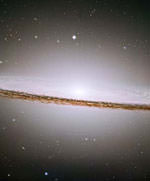
Image credit: Hubble
The newest image from the Hubble Space Telescope is of the Sombrero Galaxy, which was pieced together from a mosaic of six images taken by Hubble’s Advanced Camera for Surveys. The Sombrero Galaxy is quite large; visually it’s one-fifth the size of the Moon in a telescope. This release marks the fifth anniversary of the Hubble Heritage Project, which uses telescope time to release beautiful astronomy images to the public.
The Hubble Heritage Team of astronomers, who assemble many of the NASA Hubble Space Telescope’s most stunning pictures, is celebrating its five-year anniversary with the release of the picturesque Sombrero galaxy. One of the largest Hubble mosaics ever assembled, this magnificent galaxy is nearly one-fifth the diameter of the full moon. The team used Hubble’s Advanced Camera for Surveys to take six pictures of the galaxy and then stitched them together to create the final composite image. The photo reveals a myriad of stars in a pancake-shaped disk as well as a glowing central bulge of stars.
Since its inception in 1998, the Hubble Heritage Project has released more than 65 images of dazzling celestial objects, including planets, dying stars, regions of star formation, clusters of stars, individual galaxies, and even clusters of galaxies. This has been done on a monthly basis.
The Heritage team of Space Telescope Science Institute astronomers and image processing specialists selects images from the Hubble Space Telescope’s public data archive. This database contains approximately 500,000 raw images taken over the past 13 years. Although astronomers use Hubble to photograph numerous celestial objects, those results are usually shared with only the astronomical community. The Heritage team periodically combs the archive looking for interesting, but unreleased, pictures to become Heritage image candidates.
“Some of the photogenic objects that have been scientific targets often lack sufficient exposure across a range of colors,” explains Keith Noll, the Heritage lead scientist. “In other archival images the telescope’s field of view only covers a small, unrecognizable portion of the object, so we have to fill in the rest.”
The Hubble Heritage Project has been granted a small amount of observing time to essentially “fill in the gaps” in these images. The Heritage astronomers also seek visually interesting objects in the universe that have not yet been selected for Hubble scientific observations. For the Sombrero galaxy, the Heritage program devoted a number of orbits to complete a photo mosaic of the object.
Public visitors to the Heritage website (http://heritage.stsci.edu) have also been invited to help select attractive astronomical targets. One overwhelming choice of the voters was the famous Horsehead Nebula in the constellation Orion the hunter.
The Heritage program has been recognized for its contribution to inspiring the public with some of the most photogenic images ever produced in astronomy. Recent achievements for the team include the Astronomical Society of the Pacific 2003 Klumpke-Roberts award for “outstanding contributions to the public understanding and appreciation of astronomy.” In 2002, two Heritage images were selected in the Rochester Institute of Technology’s “Images From Science” traveling gallery exhibit. Several images have been selected by the US and UK postal systems. In 2000, a first-class US postage stamp showing the Ring Nebula was one of five Hubble images selected to be part of a commemorative series of stamps honoring astronomer Edwin P. Hubble.
Hubble’s new Advanced Camera for Surveys, and eventually the planned Wide Field Camera 3, promise to give the Heritage team an opportunity to share with the public even more opulent views of our colorful universe.
Original Source: Hubble News Release
Orbital Wins Air Force Launch Contract
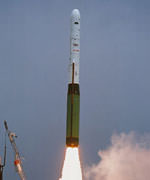
Image credit: Orbital
Orbital Sciences announced on Thursday that they have been given an $11 million contract by the US Air Force to launch a classified satellite payload on a Minotaur rocket. Three other payloads are currently scheduled to launch on Minotaur rockets, which are rebuilt Minuteman ICBMs for the first and second stages, and then the third and fourth stages are from a Pegasus XL rocket. The launch is scheduled for 2005.
Orbital Sciences Corporation (NYSE: ORB) announced today that the U.S. Air Force has exercised an option order for a Minotaur space launch vehicle under the 10-year Orbital/Suborbital Program-2 (OSP-2) contract that was awarded to the company earlier this year. The Minotaur order is the first to be placed under the OSP-2 contract, which is valued at up to $475 million over 10 years on an indefinite delivery/indefinite quantity basis. The new order increases the launch manifest for the Minotaur program to four missions to be carried out over the next two years. This most recent Minotaur space launch vehicle ordered by the Air Force is scheduled to launch a classified payload in 2005. In addition, Orbital is currently under firm contract to carry out three other Minotaur missions, including N-FIRE and XSS-11, both of which are scheduled to be launched in 2004, and COSMIC, scheduled for launch in 2005.
?We are very pleased to have the opportunity to conduct cost-effective military space missions for the Department of Defense,? said Mr. Ron Grabe, Orbital?s Executive Vice President and General Manager of its Launch Systems Group. ?The Minotaur program represents an efficient use of government assets and commercial technology to provide low-cost, operationally responsive and reliable launch services for U.S. government customers.?
Orbital originally developed the four-stage Minotaur rocket under the Air Force’s OSP-1 contract, which was awarded to the company in 1997. The Minotaur vehicle uses government-supplied Minuteman II rocket motors that serve as the vehicle?s first and second stages. The rocket?s third and fourth stages, as well as its guidance and control system, use technology from Orbital’s highly reliable Pegasus XL commercial rocket program.
Orbital has carried out two previous Minotaur missions, both of which were fully successful. In January 2000, Minotaur made its successful debut with the launch of the JAWSAT spacecraft. Later in 2000, the second Minotaur rocket successfully launched the MightySat-II satellite into low-Earth orbit. Both missions were conducted from launch facilities at Vandenberg Air Force Base (VAFB), CA.
Over the past several years, Orbital has experienced rapid growth in its launch vehicle programs for military space and missile defense-related missions. The company?s launch vehicle business is primarily centered at Orbital?s engineering and production facility in Chandler, AZ, where the company employs approximately 800 people. Orbital also maintains launch vehicle assembly, integration and test facilities at VAFB, where the company employs nearly 100 people.
Original Source: Orbital News Release
